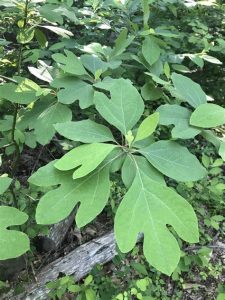Editors Note: This is recipe #2 in a series of recipes graciously offered from the community inspired kitchen of Josmine Evans, founder of the Detroit based Indigo Culinary Co. We hope you find these offerings that are rooted in critical connections with tradition, history and our present as delicious, comforting and healing as we do! See Edition 26 for recipe #1, a delicious and comforting pot of homemade collard greens!
Author’s Note: Keep in mind, I’m a storyteller, not a doctor or a representative of the FDA so be advised this information has not been evaluated by the Food and Drug Administration. This product is not intended to diagnose, treat, cure, or prevent any disease and is for educational purposes only.
Detroit is a city rooted in resilience and so is the sassafras tree. Native to North America and long revered by Indigenous peoples, the sassafras tree (Sassafras albidum) offers a distinctive aroma and mitten-shaped leaves. As a symbol of healing, adaptation, and renewal, it’s roots, bark, and leaves have been used for centuries in medicines, teas, and dishes like gumbo, carrying traditions across generations. As spring approaches, sassafras invites us to reflect on renewal for our bodies and for our communities. It’s a reminder of the wisdom held in our relationships with the land and each other, and of the power we have to build sustainable systems of care that resist exploitation and uplift collective well-being.
The tradition of spring tonics is rooted in the cycles of the earth. After a long winter, the arrival of fresh greens and herbs is a gift to communities who rely on grains, starches, and preserved foods to get through colder months. Sassafras tea, made from the tree’s roots and bark, is one of these seasonal gifts, used to cleanse the body, boost circulation, and prepare for the vitality of spring. This practice, first cultivated by Indigenous peoples, became a shared tradition when Africans arrived in the Americas and learned to use local plants. Together, these communities built systems of knowledge that sustained them in hostile conditions, blending ancestral wisdom with the resources of the land.
In today’s world, where access to health care is inequitable and profit-driven, being in relationship with the land is an act of resistance. Sassafras reminds us that healing isn’t always something we have to buy and that nature itself offers powerful tools for care when we take the time to listen and learn. Detroit’s history as a city of community builders speaks to this legacy. Through food sovereignty movements and urban farming, we’re reclaiming agency over how we nourish ourselves and our communities. Sassafras, as both a medicine and a symbol, reflects the importance of preserving our connection to the land; not just for personal well-being, but as a collective resource for resilience.
Sassafras’ legacy hasn’t escaped the impacts of the medical industrial complex. Its safrole content, a compound found in the root bark, was flagged in the 1960s for potential carcinogenicity, leading to its removal from commercial products like root beer. But this regulation often overlooks the wisdom of Indigenous and African American communities, who have used sassafras in moderation and with intention for centuries. Safrole’s controversy is a reminder that science doesn’t always account for cultural knowledge or nuanced use. While it’s important to approach sassafras with care, it’s equally important to honor the traditions that have valued it as a seasonal medicine, a culinary staple, and a spiritual ally.

Sassafras is perhaps most contemporarily known for its role in gumbo, where dried and ground leaves are used to make filé powder. Filé not only thickens the stew but also adds a layer of earthy, aromatic flavor that connects the dish to its Indigenous roots and African American evolution. Adding filé to gumbo is a way of honoring the communal meals that have sustained generations. Sassafras tea, on the other hand, uses the roots and bark to create a bright, spicy infusion that serves as a spring tonic. While its use requires care, sassafras tea continues to be celebrated for its ability to align the body with the season of renewal.
Sassafras Root Tea Recipe
Ingredients:
- 2 tablespoons dried sassafras root bark (sourced sustainably)
- 4 cups water
- 1 cinnamon stick (optional)
- 1 teaspoon honey or molasses (optional)
Instructions:
- Rinse the sassafras root bark to remove debris.
- Combine the root bark, water, and cinnamon stick (if using) in a small pot.
- Bring to a boil, then reduce heat and simmer for 15-20 minutes.
- Strain the liquid into a mug and sweeten with honey or molasses if desired.
Note: Use sassafras sparingly and consult with a knowledgeable herbalist if you have concerns.
Sassafras is a living archive of shared knowledge, cultural exchange, and collective care. By reclaiming our relationships with plants like sassafras, we can build systems of nourishment that are accessible, sustainable, and grounded in community. Detroit’s urban gardens, cooperative kitchens and grassroots movements are part of this legacy. They remind us that healing doesn’t always require permission from the medical industrial complex and that the answers we seek often lie right outside our doors. Sassafras, with its deep roots and rich history, invites us to reconnect with the land, with our ancestors, and with each other.
*While sassafras is native to Michigan, it’s not especially prolific in the city of Detroit; however, you can find them in Oakland County parks like Addison Oaks, Highland Oaks, Independence Oaks, and Rose Oaks. theJOYproject, a Living Archive of Afro Atlantic Agriculture and Foodways in Detroit’s North End, will be planting baby sassafras trees in the spring.
Josmine Evans weaves together food, culture, and storytelling through her work at Indigo Culinary Co. Evans offers her collection of stories and experiences, affirming collective identities and planting seeds for future generations to appreciate the rich tapestry of African diaspora cuisine. Learn more about her work @indigoculinaryco.com


